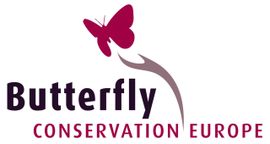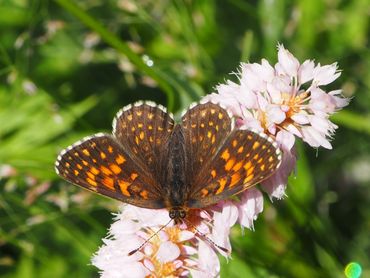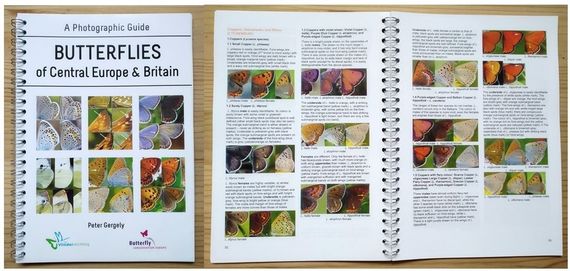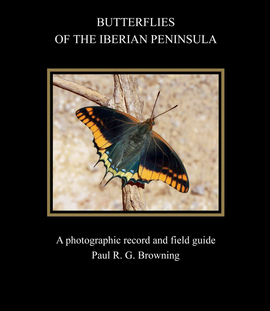Butterfly Identification

Butterflies are one of the most conspicuous insect groups, with wonderful colour and shapes. However, sometimes their identification is not easy and we need precise keys to identify butterflies. On this page, you can find information, free resources including books and field guides, and several options for searching online.
First, it is important to differentiate butterflies (Rhopalocera) from moths (Heterocera), and then determine the proper family an individual belongs.
Identification Basics
In Europe, we have 6 different families:
- Hesperiidae - Skippers
- Papilionidae - Apollos, Festoons and Swallowtails
- Pieridae - Whites and Yellows
- Riodinidae - Metalmarks
- Lycaenidae - Blues, Copper and Hairstreaks
- Nymphalidae - Fritillaries, Admirals, Emperors, Gliders, Browns and Heaths
In the following video, Martin Warren explained the main characteristics of butterfly families and how to recognise them:
Identification with Field Guides
eBMS Field Guides
There are many resources to help in butterfly identification such as websites, books, and field guides. The latter can be very helpful in the field because the key characteristics of each species are highlighted enabling the user to correctly identify the butterfly observed.
In the ABLE project and eBMS, we produced several Field Guides per region for specific regions. In each of these, only the butterflies that occur in the region are included, reducing the number of species illustrated and hopefully making it identification easier for the user. You can download the pdf and print a copy of the Field Guide for the following regions:
- Field Guides of Italy: Padana Plain region, Mediterranean, Apennines, Mediterranean Islands (in Italian)
- Field Guides of Spanish regions: Andalucia (Spanish) & Andalusia (English), and Castilla-La Mancha (English) & Castilla-La Mancha (Spanish), common species whole Spain in Spanish and English
- Field Guide of Slovenia: English and Slovenian version (common species)
- Field Guide of Cyprus (English)
- Field Guides of Austria: Vienna (German) and Lake Neusiedl Region German and English
- Field Guide of Poland: Polish version (common species)
- Field Guide of Lithuania: English and Lithuanian version
- Booklet Common species Portugal Continental (Portuguese) and Field Guide Madeira Portuguese and English version
- Field Guide of Corfu (Greece): Greek and English version
- Field Guide of Malta: in Maltese and English version
You can also find all these Field Guides, species list per country and region and more information on the eBMS website

EBG Field Guides: species groups
The European Butteflies Group (EBG) has produced a series of field guides to help with identifying difficult species groups. These field guides illustrate both the upper and undersides of each species, and highlight the key identification features. You can download all these guides for free:
- Pyrgus Group of Grizzled Skippers: this guide illustrates how to identify the sixteen species in this group, as well as separate them from the Spialia and Muschampia genera of skippers. These species are all very similar and can be difficult to separate, so the guide includes images of both upperside and underside with characteristic markings highlighted. You have the option of downloading high resolution (45mb) or medium resolution (12mb)
- European Fritillaries: this comprehensive guide to all the European fritillaries, enables the user to first identify which genus a fritillary butterfly belongs. The guide then goes on to illustrate the key identification features of each species within that genus. Download this guide (large file -66mb)
- Large and Medium Fritillaries: this field guide focuses on the eleven species belonging to the Argynnis, Brenthis, Fabriciana, Issoria, and Speyeria genera. Download the high resolution (16mb) or low resolution (4mb)
- Small Fritillaries: 1. Boloria genus - the identification features of all fifteen species of Boloria are covered by this field guide. Download the high resolution (22mb) or low resolution (6mb)

- Small Fritillaries: 2. Euphydryas - The six species of Euphydryas are illustrated in this guide, including subspecies and difficult forms. Download (11mb)
- Small Fritillaries: 3. Melitaea - This group of sixteen species now includes the old sub-group of Mellicta which traditionally posed the greatest identification problems for European butterfly recorders. Download the high resolution (18mb) or low resolution (5mb) version.
- Whites: Pieris - A complete guide to identify all eight European species of Pieris with notes to distinguish them from other similar genera. Download (9mb)
- Brimstones: Gonepteryx. . This guide focuses on distinguishing between the three Gonepteryx species found on mainland Europe. Download (3mb)
© Copyright Butterfly Conservation: These guides are made available for private use only. Any form of commercial usage is forbidden.
Many thanks to Bill Raymond for designing the ID guides above. Thanks to Bernard Watts for information and photographs, to Matt Rowlings, Roger Gibbons, Nick Greatorex-Davies, David Moore and Vincent Baudraz for photographs and to Richard Lewington for the use of his illustrations. Thanks also to LepiDiv for permitting the use of their distribution maps.
Butterfly Books
A Photographic Guide - Butterflies of Central Europe & Britain

This photographic guide enables the identification of the 269 butterfly species occurring in Britain, Western and Central Europe. The first part of the guide describes the identification features of each butterfly family and subfamily and the second part illustrates the identification characteristics of closely related and similar species. The photographs in this guide are all taken in the field and show the butterflies in their natural position.
Author Peter Gergely.
Butterflies of the Iberian Peninsula
The Butterflies of the Iberian Peninsula by Paul R. G. Browning (pdf English) can be downloaded free from the European Butterflies Group website. This is a revised version that covers all the butterflies occuring in Spain and Portugal. Photographs of both the butterfly and its habitat are included, together with descriptions of identification features, habitats, larval hostplants and distribution.
Identification on the website
There are many websites on the internet that could help a lot in butterfly identification in different languages. Here we give a list of the best website to help you identifying butterflies and moths:
- Lepiforum Determination of butterflies and their preimaginal stages (German)
- www.leps.it Moths and Butterflies of Europe and North Africa by Paolo Mazzei, Daniel More and Raniero Panfili
- www.learnaboutbutterflies.com Learn About Butterflies by Adrian Hoskins
- www.eurobutterflies.com euro Butterflies by Matt Rowlings
- UFZ Distribution maps Butterflies of France by Roger Gibbon
- Butterflies of Bulgaria Butterflies and Moths of Bulgaria by Nick Greatorex-Davies
You can also view distribution maps of European butterflies here:
www.ufz.de/european-butterflies Gallery of distribution maps of European butterflies

